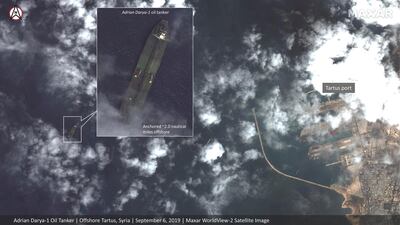US national security adviser John Bolton accused Tehran of "lying and spreading terror" in a tweet which appeared to show the Iranian tanker Grace 1 at anchor near the Syrian port of Tartus.
Mr Bolton shared a satellite photograph on Saturday showing the tanker, now renamed Adrian Darya 1, only two nautical miles from the deep-water port.
"Anyone who said the Adrian Darya 1 wasn't headed to Syria is in denial," Mr Bolton said.
“Tehran thinks it’s more important to fund the murderous Assad regime than provide for its own people."
The tweet came after a report suggested that the tanker had partly offloaded its cargo of oil in Syria.
The ship had disappeared from tracking systems after disabling its beacon on Tuesday, sparking fears that assurances from Iran that the ship would not deliver its cargo of crude oil to President Bashar Al Assad’s regime would be proved false.
Several hours before Mr Bolton’s post, the maritime watchdog Tanker Trackers had posted a satellite photograph to Twitter taken on Thursday which it said located the ship near the port.
The vessel, carrying 2.1 million barrels of Iranian crude worth about $130 million (Dh447.4m), was released by authorities in Gibraltar in August after being detained in an operation by British commandos on July 4. The ship had been seized over suspicions that it was delivering the oil to a refinery in Baniyas, Syria, in violation of EU sanctions against the Assad regime. Authorities in Gibraltar, a British territory, said was the tanker was released after receiving assurances from Iran that its cargo would not be delivered to Syria.
US officials, surprised when the Gibraltar court released the vessel, said the UK had made a mistake in trusting the word of Iranian Foreign Minister Javad Zarif.
US Secretary of State Mike Pompeo said on August 31 that Washington had “reliable information” that the tanker was heading to Syria.
The US issued a warrant for the ship to be seized, saying it was part of a network of vessels being operated by Iran’s Revolutionary Guards to supply oil to the Syrian regime.
Washington recently listed the paramilitary group a terrorist organisation, giving it greater power to pursue its assets.
The US sanctions against the Revolutionary Guard are a part of a campaign to put "maximum pressure" on Iran to curb its missile programme, stop destabilising the Middle East region through support of armed proxies, and to renegotiate a 2015 deal with world powers to prevent Tehran acquiring nuclear weapons. President Donald Trump pulled the US out of the nuclear deal last year.
The US sanctions on Iran's vital oil exports have escalated tensions in the Gulf region in recent months, with a series of unclaimed attacks on oil tankers that Washington has blamed on Tehran. Iran has also seized a number of foreign vessels including oil tankers and threatened to block the Strait of Hormuz – a chokepoint for a third of world's seaborne oil.
In the latest incident, Iran seized a boat and arrested 12 Filipinos as it busted a "fuel-smuggling ring" in the Strait of Hormuz on Saturday, the semi-official news agency ISNA reported.
"A foreign tugboat was confiscated as well as 283,900 litres of petrol worth US$20.2 million," ISNA said, citing the coast guard chief in the southern province of Hormozgan.
"Twelve Philippine nationals were arrested and the relevant judiciary officials are currently taking the required legal measures," Major Hossein Dehaki was quoted as saying.
Maj Dehaki said the group was suspected of operating a fuel-smuggling ring and the confiscated shipment had been intercepted close to Sirik county in the Strait of Hormuz.
Iran's Islamic Revolutionary Guard Corps detained a "foreign tanker" in Gulf waters on July 14 for allegedly smuggling contraband fuel.
"With a capacity of two million litres and 12 foreign crew on board, the vessel was en route to deliver contraband fuel received from Iranian boats to foreign ships," the Guards said at the time.
Maritime tracking service TankerTrackers reported the Panamanian-flagged MT Riah, used in the Strait for fuelling other vessels, had crossed into Iranian waters, and at that point its automatic identification system stopped sending signals.
In the most high-profile seizure, the Guards impounded the British-flagged Stena Impero tanker in the Strait of Hormuz on July 19 for breaking "international maritime rules".
Britain strengthened its naval presence in the Gulf after the incident and has agreed to join an international coalition proposed by the US to protect international shipping in the region.











